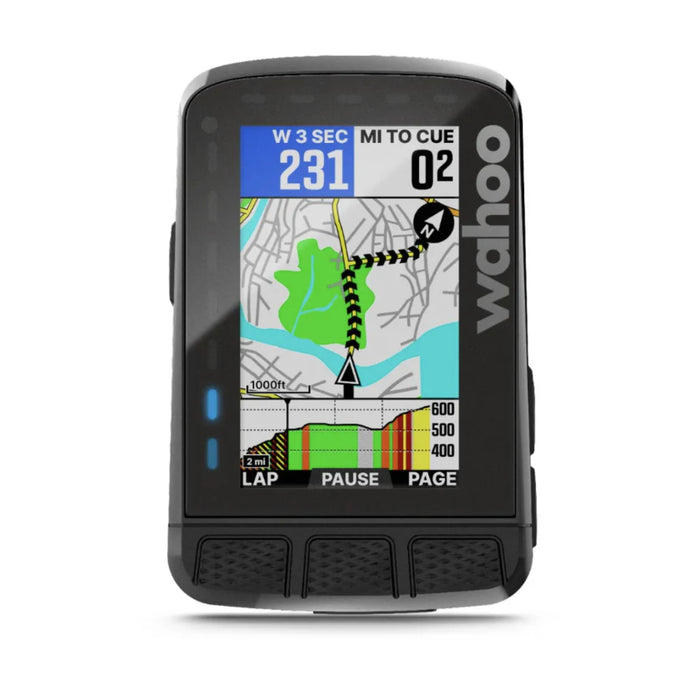
wahoo ELEMNT ROAM GPS V2 CYCLING COMPUTER
incl. FREE shipping & free returns

Von Fabian Huber |
5 minutes read time

This article is about GPS tracking for cyclists, more specifically displays and their features that enable effective and accurate navigation on bike paths. This article will explore the various aspects and benefits of GPS tracking for cyclists, including helpful features like displaying bike paths and how to use them ideally. It will also cover various popular brands, including Wahoo. The goal is to provide an insight into the amazing capabilities of bike navigation technology and why it is practically irreplaceable for every cyclist today.
GPS navigation while cycling has become indispensable for several reasons. One of the main advantages is accurate route guidance. Imagine you are in an unfamiliar city or on a complex mountain bike trail and just want to get from point A to point B safely and efficiently. This is where GPS navigation comes in. With a reliable GPS app on your smartphone or a dedicated bike navigation system, you can:
In addition, many GPS systems and apps offer additional features, such as recording your trips, sharing your route with friends or emergency alerts in case of accidents.
GPS navigation also supports your safety on the bike. It helps you avoid busy roads and stay on safe bike paths. With GPS navigation, you have a useful tool at hand that not only makes navigation easier, but also increases your safety on the bike. This makes it an indispensable companion for all cyclists, whether in urban commuting, on rural bike paths or on adventurous mountain bike tours.
Choosing the perfect GPS tracker for your cycling adventure can be challenging as there are many models with different features. Some of the most important aspects to consider include:
A concrete example of a recommended GPS tracker is the Garmin Edge 830. It offers high accuracy thanks to GLONASS support, a battery life of up to 20 hours and numerous additional functions such as an altimeter and pre-installed maps. It is also robust and waterproof.
If you follow these tips, you're sure to find the perfect GPS tracker for your next cycling adventure.
GPS technology has revolutionized the way we navigate on a bike. Instead of relying on printed maps or complex instructions, we can now simply use a GPS device or an app on our smartphone to find our way. Here are the most important aspects you should know:
So, using GPS technology can not only make navigation easier, but also help to improve the overall cycling experience. Being able to discover new trails and plan routes in advance allows you to experience your surroundings in a whole new way. Most importantly, you can stay safe and focus on the ride.
Connected technologies like GPS tracking are ubiquitous in today's digital world and offer a variety of benefits. One area where they can be particularly useful is emergency rescue. Whether you're hiking up a mountain, cycling or commuting, GPS tracking can save lives in an emergency. Here are some reasons why:
To make the most of these benefits, it is important to always have a GPS-enabled device with you, such as a smartphone or a special GPS device. Many bicycle navigation systems, such as those offered on myvelo.de, also have a GPS function. By using such devices, you can be found and rescued quickly in an emergency. So it's more than just a matter of convenience - it can actually save lives.
An important aspect of using a GPS device is battery life. To be able to travel for longer, there are some useful tips that can help you maximize battery life. A basic tip is to adjust the screen brightness. High brightness can drain the battery quickly, so set the brightness as low as possible without affecting readability.
Another aspect is the update rate. The more often your GPS device updates its position, the more energy it uses. You can reduce the update rate in your device's settings to save energy.
You should also deactivate functions that you do not need. These include Wi-Fi, Bluetooth or even backlighting. They all consume energy and can be switched off when they are not needed.
Finally, it is recommended to perform regular software updates. These often contain optimizations that can extend battery life. With these action-oriented tips, you can effectively extend the battery life of your GPS device and thus be able to travel longer.

Wer regelmäßig mit dem Rennrad unterwegs ist, kennt das Ritual: Nach einer langen Ausfahrt oder vor einem knackigen Intervalltraining führt kein Weg am Espresso vorbei. Ob in der italienischen Bar an der Strecke, auf dem Marktplatz nach dem Sonntagstraining oder zuhause aus der Siebträgermaschine – der Espresso ist fester Bestandteil der Rennradkultur. Doch was steckt hinter dieser Verbindung aus Koffein, Stil und Leistung?

Wer an Rennradfahren denkt, hat oft Bilder von durchtrainierten Beinen, kraftvollen Antritten und aerodynamischer Haltung im Kopf. Doch ein Muskel spielt eine unterschätzte, aber entscheidende Rolle: der Beckenboden. Er ist nicht nur für Stabilität und Körperkontrolle wichtig, sondern auch für Komfort, Leistungsfähigkeit – und die langfristige Gesundheit auf dem Rad.

Die Auswahl an Fahrrädern war noch nie so groß wie heute. Rennrad, Mountainbike oder doch ein Gravel Bike? Jedes dieser Bikes hat seinen eigenen Charakter, seine Stärken und idealen Einsatzbereiche. Doch wo liegen die Unterschiede – und welches Rad passt am besten zu Dir und Deinem Fahrstil? In diesem Artikel erfährst Du, was die drei Bike-Typen auszeichnet, welche Vor- und Nachteile sie haben und worauf Du bei der Entscheidung achten solltest.